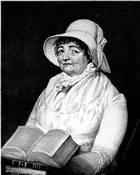 The messiah’s mother was born in Devon, England, in April of 1750. What, you didn’t know?
The messiah’s mother was born in Devon, England, in April of 1750. What, you didn’t know?
It was a strange day, featherstitched with endings and beginnings. Mobs stormed the French royals, Thomas Paine published The Rights of Man, Voltaire sewed seeds of doubt and sedition, and everywhere were new prophets and seers, feeding on spiritual anomie like the wild mushrooms of a wet, warm spring.
In England was Joanna Southcott. A simple farmer’s daughter, former domestic servant and fairly bland Methodist, she was just scraping by as an upholsteress in Devonshire. Then at age 42 she was hearing voices. She recorded them, saving the words in a box. “The writing comes extremely fast,” she said, “much faster than I could keep up by voluntary effort. I have to turn over the pages and guard the lines of writing from running into each other; but, except for this, I need not look at the paper. I can talk on other subjects while writing. The mass … consists in teachings on Religion. Some … deal with earthly matters.”
Despite reproof from a preacher, Joanna became sure she was the woman of Revelation—not the red harlot of course, but the other one, “clothed with the sun, and the moon under her feet, and upon her head a crown of twelve stars,” who births a divine child (Rev 12:1-6). It was not something to take lightly.
Awed, Joanna visited Exeter, then moved to London. In London she sold paper “seals” at from twelve shillings to a guinea each, which guaranteed one a place as one of the Elect, on the fast track to Heaven on Judgment Day. No surprise, these sold well. Now Joanna had a little money and some followers. Still the voices murmured: omens, verse and prophecy. In 1801 she published her first collection, a 48-page, nine-penny tract. It sold too. Eventually Joanna would turn out over 65 books and pamphlets.
One respected clergyman—Rev. T.P. Foley, fellow of Jesus College, Cambridge—backed her for a time, then hastily withdrew support when his name popped up a bit too often in her published letters.
To her credit, Joanna had doubts. A prophecy might fail, or scandal erupt among her followers—then she wondered if maybe it was Satan whispering in her ear. She begged Church of England bishops to review her claims; she would accept their decision, she said. The dignitaries demurred. Within the vacuum of their silence, the “Southcottian” movement grew, until by some reports Joanna had 100,000 disciples.
In 1812, at age 62, a bequest brought financial independence at last. Next year the ecstasies increased. All about she felt a gathering of angels, the brush of wings and sacred breath of God. The voices took on a new tenor. “Order twelve gowns for thy wedding,” they commanded.
Joanna was shocked. A confirmed spinster, she had no desire for marriage. The voices then added, “In the sixty-fifth year of thy age thou shalt bear a son by the power of the Most High.” Oooh. Joanna recalled her vision of spiritual motherhood. So that was it—like Mary, she would bear a divine child, from a divine source, with a divine destiny. It’s name would be Shiloh (Gen 49:10).
Followers rejoiced, gifts poured in. Joanna began to show evidence of pregnancy (reportedly, doctors confirmed it). At some point she decided her child must have a foster father, as Jesus had had Joseph, so she wed the steward of a local earl.
Joanna expected the birth in July, 1815. Came November, childless, and she once again wondered if the voices had deceived. To friends she confessed despair: “Now it all appears delusion.” Symptoms of pregnancy vanished. She grew weaker. She knew she was dying. She begged her doctor to guard her body for a few days, as it might only be a coma or trance. She died in the early morning, December 27.
Examining the body, doctors found evidence of edema or dropsy, which may have caused the false pregnancy.
Joanna left three things. One, a will, where she sadly said the Devil had deceived her, and ordered the return of all gifts to donors. The second, the box of inspired writings. The third was her following. The Southcottians, confused as ants of a shattered hill, milled, drifted and took factions. One faction decided the divine child had been born in a spiritual manner from Joanna’s side (“Thus the ethereal invisible body was taken by angels back to the Throne of God”). Most of the surviving groups reunited after the turn of the century, to form the Panacea Society of Bedford. It continues today as one of the wealthier small sects of Britain, with a worldwide membership and a presence on the Web.
What of the box? The reformed Southcottians guarded it until “all twenty-four bishops of the Church” should come to read the writings. In 1927, an advocate arranged a meeting of press and bishops—only one bishop showed. Figuring it was as good as they would get, they opened the box. Within was a romantic novel, a calendar, a pistol, a night cap, and a dice cup.
The Panacea Society said it was a false box; to this day, the true remains in a secret place. Meanwhile it also offers one-inch square bits of linen, as God instructed Joanna, with the power to heal all ailments and personality problems, but users should remain under the care of a doctor. Good idea.
Kenneth Nahigian, May 2012 – AOF Newsletter
